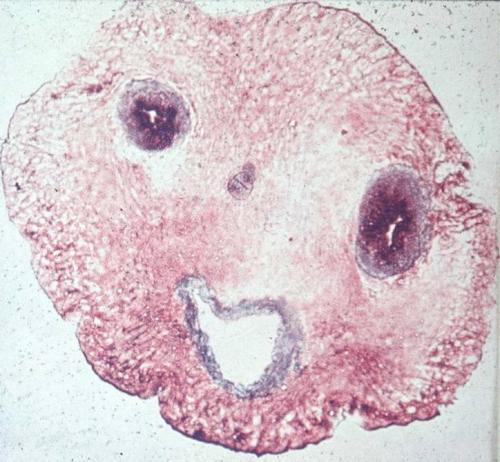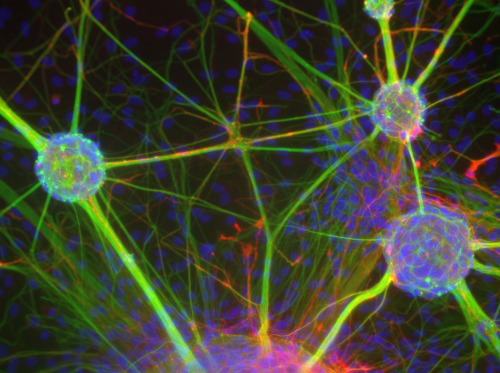Тянется моё сердце к этой теме, ничего поделать не могу. :) Вот и очередные новости о проблеме: http://www.biologynews.net/archives/2008/11/20/misreading_of_damaged_dna_may_spur_tumor_formation.html
The DNA in our cells is constantly under assault from oxygen, the sun's radiation and environmental stresses. Most of the time, our cells can repair the damage before it gets copied into a permanent mutation that could lead to cancer.
Adding a wrinkle to our understanding of how cancers begin, scientists have found that cells can turn on tumor-promoting growth circuits as a result of misreading damaged DNA without copying it: a process called "transcriptional mutagenesis."
The results are published online this week in Proceedings of the National Academy of Sciences.
"This reveals a new aspect of tumor development that could be especially important for cells that make up most of the body's tissues: differentiated cells that are not replicating their DNA," says Paul Doetsch, PhD, professor of biochemistry at Emory University School of Medicine and deputy director of basic research at Emory Winship Cancer Institute.
All cells, including non-dividing cells that are not replicating their DNA, continue to transcribe, or make RNA, from some of their genes in order to produce proteins and carry out their normal functions.
Doetsch and postdoctoral researcher Tina Saxowsky, PhD, examined what happens when mouse cells are presented with DNA pre-loaded with a damaged building block in a critical place.
The DNA encoded the gene Ras, one of the genes most often mutated in human cancers. The damage came in the form of 8-oxoguanine, which is generated when guanine, one of the four bases making up DNA, reacts with oxygen. (The four bases are: Adenine, Guanine, Cytosine and Thymine.) Cells unable to repair the damage tend to replace the modified guanine (G) with thymine (T).
"It's one of the most common forms of genetic damage," Doetsch says. "Constantly dealing with oxidation is the price we pay for breathing air."
If the cells misread the G as T during the process of transcription, some of the Ras protein they make comes in the hyperactivated form found in cancers. By looking at other proteins controlled by Ras, the authors could detect some of the cell's growth circuits starting to turn on.
By reading the RNA the cells make from the Ras DNA, Saxowsky found that even normal mouse cells misread the damaged DNA about three percent of the time. Sometimes the cell's machinery sees the damaged G as T, and sometimes it skips a letter. However, the mouse cells were more likely to misread the 8-oxoguanine (14 percent of the time) if they came from mice engineered to lack an enzyme that normally repairs the damage, called 8-oxoguanine glycosylase.
Doetsch says his group's findings suggest that DNA damage, if it hits certain critical genes in a cell, could lead to transcriptional mutagenesis that in turn spurs the cell to divide.
"Let's say that DNA damage lands in a gene that normally prevents a cell from dividing when it's not supposed to," Doetsch says. "If enough mutant proteins get made from the gene, the cell divides and the DNA is copied. Now, in one of the daughter cells the damage becomes a permanent mutation driving further growth. It's another way for tumor promotion to happen, except the growth signal needed to push the process along isn't coming from a chemical or a hormone."
He and Saxowsky are performing additional experiments to test the hypothesis that transcriptional mutagenesis can lead to cell division directly.
Transcriptional mutagenesis could explain a phenomenon seen in bacteria called adaptive mutagenesis, Doetsch says. When faced with starvation conditions, bacteria can relax their standards of accuracy when copying their DNA, apparently in an effort to mutate their way out of a dead end.
It appears that bacterial enzymes that make RNA from DNA are more susceptible to transcriptional mutagenesis than those from mammals, Doetsch notes, but further studies are required.
Cancer is essentially the "selfish" growth of a small group of cells at the expense of the person they came from, an issue that does not arise in one-celled organisms such as bacteria, he says.
Source : Emory University
22.11.2008
Опять о повреждениях ДНК.
20.11.2008
Немного о влиянии амфетамина на детей.
Некоторые новые данные: http://www.scientificblogging.com/news_releases/adhd_medication_dispute_methylphenidate_and_amphetamine_do_not_cause_genetic_damage_kids_says_study
ADHD is a disorder characterized by attention problems, impulsivity, and hyperactivity. About 3 percent of children in the United States have been diagnosed with the disorder, although some studies suggest 7 to 12 percent of children may be affected.
The study published online this month in the Journal of the American Academy of Child and Adolescent Psychiatry (JAACAP) provides new evidence that therapeutic doses of stimulant medications, such as methylphenidate and amphetamine, do not cause cytogenetic (chromosomal) damage in humans. The researchers looked at three measures of cytogenetic damage in white blood cells of each child participating in the study and found no evidence of any changes after three months of continuous treatment.
"This is good news for parents," said Kristine L. Witt, M.Sc., a genetic toxicologist at the National Institute of Environmental Health Sciences (NIEHS) and co-author on the study, which was funded through the Best Pharmaceuticals for Children Act by NIEHS and the Eunice Kennedy Shriver National Institute of Child Health and Human Development (NICHD), both parts of NIH. "Our results indicate that methylphenidate- and amphetamine-based products do not induce cytogenetic damage in children."
The researchers involved emphasize that the findings should not be interpreted as final proof of the long-term safety of stimulant drugs for the treatment of ADHD. "More research and close monitoring of children taking these medications for extended periods of time is needed to fully evaluate the physical and behavioral effects of prolonged treatment with stimulants," noted Scott H. Kollins, Ph.D., director of the Duke ADHD Program, where the study was conducted and a co-author of the paper.
The current study included 63 children, ranging from 6-12 years of age, who met full criteria for ADHD but who had not previously been treated with stimulant medications. Children in the study were divided into two groups and treated by a board-certified child psychiatrist with either methylphenidate (commercially available as Ritalin LA and Concerta) or with mixed amphetamine salts (Adderall and Adderall XR). Blood samples were taken before the medication was started to establish baseline values for the cytogenetic measures that were analyzed in the study, and a second sample was collected after three months of continuous treatment. Forty-seven children completed the full three-month treatment schedule.
The researchers found no significant differences between the two groups of children with regard to age, gender, race, body weight, height, or ADHD subtype. The groups also showed very similar ADHD symptom levels at initial screening and children in both groups responded equally well to the medication.
The researchers looked at three standard indicators of chromosomal damage: structural chromosomal aberrations (breaks in chromosomes), micronuclei (small nuclei consisting of chromosome fragments produced by breakage or whole chromosomes lost from the main nucleus after the cell divides), and sister chromatid exchanges (exchanges of genetic material between a pair of identical chromosomes). "We did not see any significant treatment-related increases in any of these three endpoints," said Donald R. Mattison, M.D., senior advisor to the director at NICHD. "These results add to a growing body of evidence that therapeutic levels of these medications do not damage chromosomes," he said.
The study was designed to determine the reproducibility of findings from a previously published paper that reported methylphenidate-induced chromosomal changes in children with ADHD. That paper raised concern for the medical community and parents, given that some of the changes have been associated with an increased risk of cancer. The current study was not able to replicate the findings from the previous study. The new JAACAP paper extends the literature by using a larger sample size than previous studies, investigating more than one commonly prescribed medication, and providing well-characterized results that can be generalized to other ADHD populations.
"One way scientists evaluate each other's work is by attempting to reproduce the original experiment or study," said Witt. "We designed a study with specific modifications to address issues raised with the original study. Thus, our results are based on a significantly larger number of children who were carefully evaluated using rigorous, accepted standards, which allowed us to produce high-confidence data at the end of our study."










